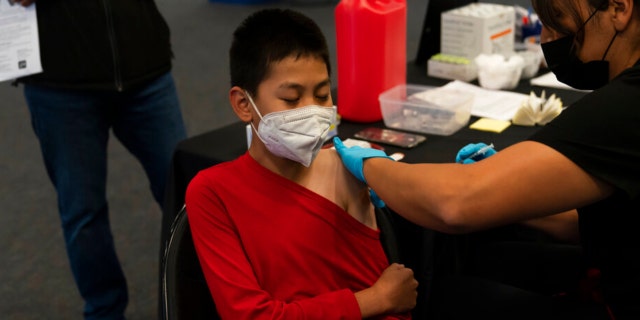This July 4th, COVID is still killing hundreds of Americans each day

health Eshrag:
NEWYou can now listen to Fox News articles!
Summer in America right now — in terms of the coronavirus — means many infections but relatively few deaths compared to prior versions of the virus, said officials cited by the Associated Press.
COVID-19 is still killing hundreds of Americans each day — yet the virus is not nearly as dangerous as it was last fall and winter.
“It’s going to be a good summer and we deserve this break,” Ali Mokdad, a professor of health metrics sciences at the University of Washington in Seattle, told the AP.
With more Americans shielded from severe illness through vaccination and infection, COVID-19 — at least for the time being — has transformed into an unpleasant, inconvenient nuisance for many.
ADVENTUROUS CHILDHOOD PLAY MAY BUFFER AGAINST ANXIETY AND DEPRESSION: STUDY
“It’s like having a bad cold or the flu,” one woman in Massachusetts said recently.
She also said, “If I get it, I get it — and I’ll get over it.” She’s been doubled vaxxed and boosted against COVID, she said.
A child wears a face mask on the first day of New York City schools, amid the coronavirus (COVID-19) pandemic in Brooklyn, N.Y., back in Sept. 2021.
(REUTERS/Brendan McDermid/File Photo)
Depending on location, many Americans are still wearing masks when they enter grocery stores or go to other public places, even though the stores or venues may not require them. Many are still masking up outdoors, too, when they’re among large crowds.
Some shops are also still requiring masking in order to enter.
Yet other Americans want nothing to do with masks at this point.

Visitors walk past a memorial for victims of COVID-19 at the Griffith Observatory, on Friday, Nov. 19, 2021, in Los Angeles. Thousands of flags were placed on the lawn in front of the observatory in memory of those who have died of COVID-19 in Los Angeles County as of Nov. 2.
(AP Photo/Marcio Jose Sanchez )
Dr. Dan Kaul, an infectious diseases specialist at the University of Michigan Medical Center in Ann Arbor, told the AP that things “feel cautiously good right now.”
“For the first time that I can remember, pretty much since it started, we don’t have any [coronavirus] patients in the ICU,” he said.
As the nation marks July 4th this year, the average number of daily deaths from COVID-19 in the U.S. is hovering around 360.
AMERICA THE BEAUTIFUL; 50 MUST-SEE LANDMARKS THAT TELL OUR NATIONAL STORY
Last year, during a similar summer lull, that number was at roughly 228 per day in early July.
That remains the lowest threshold in U.S. daily deaths since March 2020, when the virus first began to spread across the U.S.
Today, in the third year of the pandemic, it’s easy to feel confused by the mixed picture.
But there were far fewer reported cases at this time last year — fewer than 20,000 a day.
Now, it’s about 109,000 — and likely an undercount as tests done at home aren’t routinely reported.
Today, in the third year of the pandemic, it’s easy to feel confused by the mixed picture: Repeat infections are increasingly likely, the AP reported, and a sizeable share of those infected will face the lingering symptoms of what has become known as long COVID-19.

People traveling by plane during the coronavirus pandemic are shown wearing face masks as they walk through an airport terminal.
(iStock)
Many worries are also now eased, however.
“We’re now at a point that everyone’s immune system has seen either the virus or the vaccine two or three times by now,” Dr. David Dowdy, an infectious disease epidemiologist at Johns Hopkins Bloomberg School of Public Health, told the AP.
“What we’re seeing is that people are getting less and less ill on average,” Dowdy said.
As many as 8 out of 10 people in the U.S. have been infected at least once, according to one influential model, the AP pointed out.
Big differences separate the flu from COVID-19. Health experts continue to be surprised by the behavior of the coronavirus.
Recently the death rate for COVID-19 has been a moving target. It’s now it’s fallen to within the range of an average flu season, according to data analyzed by Arizona State University health industry researcher Mara Aspinall.
At first, some people said coronavirus was no more deadly than the flu — “and for a long period of time, that wasn’t true,” Aspinall said.
Back then, people had no immunity. Treatments were experimental — and vaccines weren’t yet available en masse.

A youngster receives a COVID-19 vaccine at a pediatric vaccine clinic for children ages 5 to 11 set up at Willard Intermediate School in Santa Ana, Calif., on Tuesday, Nov. 9, 2021.
(AP Photo/Jae C. Hong, File)
Aspinall said that today, the built-up immunity has driven down the death rate to solidly in the range of a typical flu season. (In the past decade, the death rate for the flu was about 5% to 13% of those hospitalized.)
Big differences separate the flu from COVID-19. Health experts continue to be surprised by the behavior of the coronavirus. It’s also still unclear whether it will settle into a flu-like seasonal pattern.
Last summer — when vaccinations first became widely available in the U.S. — the U.S. had to suffer through the delta surge and then omicron, which peaked last February and took the lives of 2,600 Americans a day, the AP reported.
The fast-spreading omicron subtypes BA.4 and BA.5 may also contribute to a change in the death numbers, said experts.
Experts agree it is possible that a new variant might arise and be capable of escaping the population’s built-up immunity. The fast-spreading omicron subtypes BA.4 and BA.5 may also contribute to a change in the death numbers.
CLICK HERE TO GET THE FOX NEWS APP
In the next weeks, deaths could edge up in many states but the U.S. as a whole is likely to see deaths decline slightly, said Nicholas Reich, who aggregates coronavirus projections for the COVID-19 Forecast Hub in collaboration with the Centers for Disease Control and Prevention (CDC).

People walking down the street are shown wearing masks against COVID-19.
(AP)
“We’ve seen COVID hospitalizations increase to around 5,000 new admissions each day from just over 1,000 in early April. But deaths due to COVID have only increased slightly over the same time period,” said Reich, a professor of biostatistics at University of Massachusetts Amherst.
Unvaccinated people have a six times higher risk of dying from COVID-19 compared with people with at least a primary series of shots, the CDC estimated based on available data from April.
US RELIGIOUS LEADERS EXPLAIN WHY FAITH IN GOD HIT LOWEST LEVEL EVER, SAY COVID MADE IT WORSE
This summer, consider your own vulnerability and that of those around you, especially in large gatherings since the virus is spreading so rapidly, said Dowdy of Hopkins.
“There are still people who are very much at risk,” he said.
Many vaccinated Americans, however, are shunning yet another booster.
GOING AWAY THIS SUMMER? MAKE SURE TO AVOID CARBON MONOXIDE POISONING
“I’m double-vaccinated and I’ve been boosted once,” one New Yorker told Fox News Digital. “That’s enough. No more boosters for me.”
He also pointed out that in his “civilian” opinion (he is not a doctor), it’s quite possible that those who are perishing from COVID today had pre-existing conditions or other complications.
The Associated Press contributed reporting to this article.
Noting that the news was copied from another site and all rights reserved to the original source.
xnxx,
xvideos,
porn,
porn,
xnxx,
Phim sex,
mp3 download,
sex 4K,
Straka Pga,
gay teen porn,
Hentai haven,
free Hentai,
xnxx,
xvideos,
porn,
porn,
xnxx,
Phim sex,
mp3 download,
sex 4K,
Straka Pga,
gay teen porn,
Hentai haven,
free Hentai,


